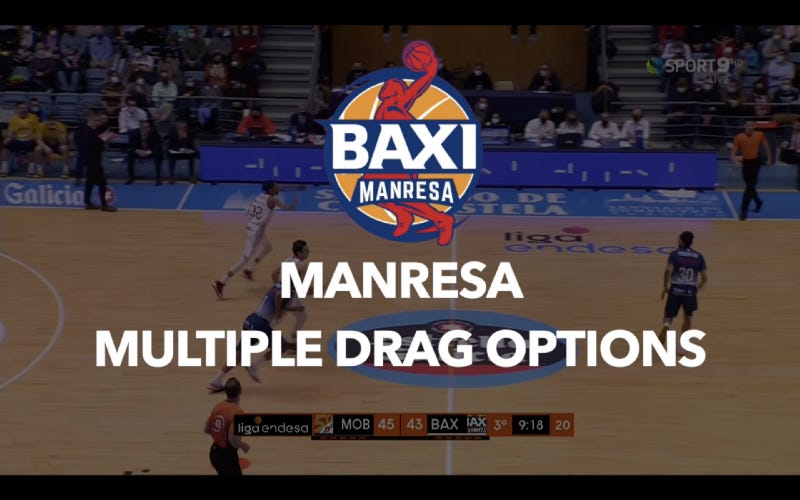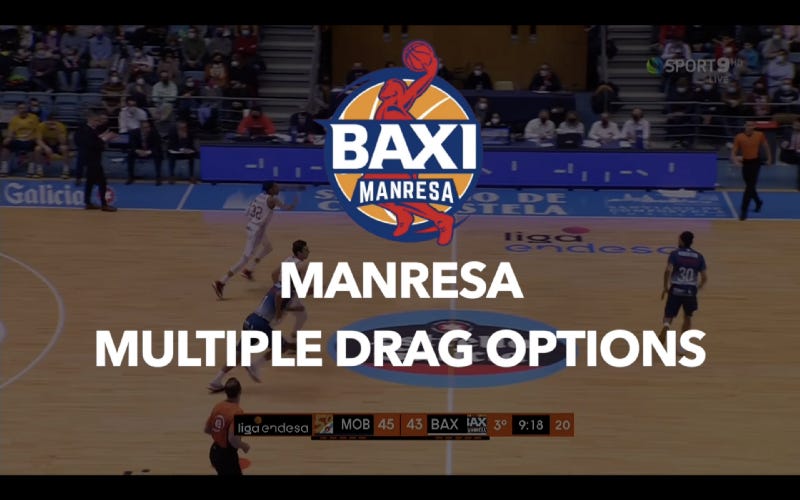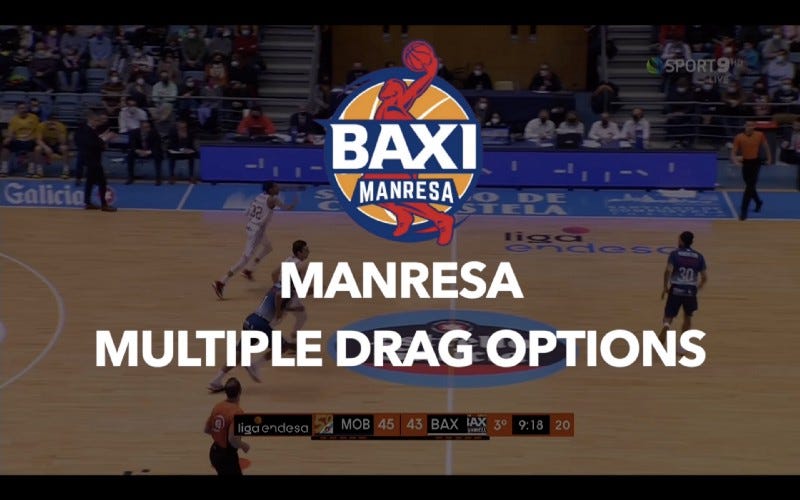Little twists to the traditional ball screen in transition
A very quick commentary on this video that I’ve posted on youtube where you can see how Manresa and coach Pedro Martinez use the ball screen in transition to generate good loo
Low Drag: With this term, I mean playing an empty side P&R very deep on the court, below the FT extended, in some situations you see the offense going almost all the way to the corner before getting to the middle of the floor toward the ball screen, why is this effective?
It stretches the defense out and forces them to take hard decisions, who’s gonna be in front of the ball? In transition, many defenses especially in Europe show a strong nail help from the closest man in the middle of the floor, this kind of spacing makes it harder to do that.
It can be effective against other coverages as well, if the defense wants to be aggressive putting 2 on the ball it’s hard to help all the way from the opposite corner on the short roll along the baseline.
Now, my first thought honestly when I saw this was to ICE this sort of P&R, and this can be for sure a good way to limit the space for the guard but it can open up a huge amount of space for the screener, if he simply pick&stay, or plays a little short roll, the distance between him and the closest defender is way larger than it would be in a normal drag screen played above the FT line, so either to shoot it or to create in a 4v3 scenario there’s gonna be space to play from that catch for your screener.
This solution has been used for some years in the NBA especially to try to prevent the defense from going under the screen, or at least to compromise that coverage, I’ll leave a gif here of the Jazz using this action for Rubio, here the defense goes over the screen, but in many situations even trying to go under it the offense is able to end up deeper in the paint than it would by playing a normal drag vs. an under.
Punch drag: Drag going toward the baseline, a flat screen that let the guard drive toward the baseline, this action is valuable and useful in itself but I really like how Manresa combines these 2 actions together when they’re not able to generate a clear advantage out of it (the defense goes back to being neutral), they re-screen the ball, finding themselves once again in their previous spacing that we called “low drag”.
Once again, this tool can be used with slightly different goals versus different coverages:
Vs. aggressive coverages: It affords you to bring the opposite big man all the way up to the sideline and creates space for the short roll in the middle of the floor, with a long way to recover for the opposite big man
Vs. Switches: It’s a perfect spacing to use a concept like the “touch screen” (find more on that here: https://twitter.com/Franz_NanniBK/status/1517121154095497217), or in general to screen the low side of the defender and play with the big either with an immediate pocket pass or using a 3rd player and a triangle with the big keeping the defender on the high-side and creating space for the lob
4 Drag into flare: The last solution that we see as part of these options is the ball screen toward the middle of the floor set by the 4, who then runs into a flare screen by the 5, this can lead to a catch with advantage for the 4, a slip by the 5 if the defense tries to switch the flare screen (very dangerous idea!) or by a 1–5 P&R where 5 maybe is going to be able to arrive with some separation since X5 has to protect the flare a little bit.
Once again I think it’s useful not to think about this action in a vacuum but as part of a system with the others, if the offense continues to play the low drag and find success with that maybe the defense is going to adjust and try to pick the ball up early, not allow the guard to dribble all the way down, but in doing so they will let the ball drive toward the middle with speed (the defense cannot take those 2 things away at the same time!), and this is where this particular action can be successful.
I think, even though I haven’t watched Manresa playing this solution against a team that switches 1 to 4, that this spacing can be effective against that solution as well, being able to generate solutions to attack the 4 man in space toward the middle of the floor, but also to involve him in a P&R 1–5 where the 2 defenders are actually 4 and 5, what the defense is going to do there? Not only in terms of coverage but in the amount of separation that 1 can generate against X4, who is probably not used to guard top P&R at the top of the key, and as we all know try to switch an action where the ball creates separation before can be very dangerous, opening up the risks of easy slips and 2v1 opportunities.
I hope you find some interesting ideas in this offense, I’m a huge fan of Pedro Martinez, I was lucky enough to watch him coach live for 2 weeks when I was visiting Vitoria in 2018, he was nothing less than a real open book for me, I was a 24 yo coach at his first experiences and he was coming over in the standings after every practice to ask me if I had questions or any comments about what happened, a real inspiration for me!








